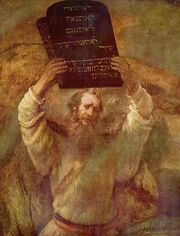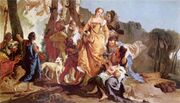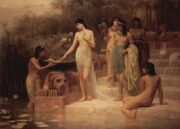<templatestyles src="Hlist/styles.css"></templatestyles><templatestyles src="Plainlist/styles.css"></templatestyles><templatestyles src="Module:Sidebar/styles.css"></templatestyles>
| Judges in the Hebrew Bible <templatestyles src="Script/styles_hebrew.css" />שופטים |
|---|
| Italics indicate individuals not explicitly described as judges |
| Book of Exodus |
| Moses |
| Book of Joshua |
| Joshua |
| Book of Judges |
| First Book of Samuel |
|
Eli *Samuel |
Moses or Móshe (מֹשֶׁה, Standard Hebrew Móše, Tiberian Hebrew Mōšeh, Arabic موسى Musa, Spanish Moisés, Ethiopic ሙሴ Musse) was a son of Amram and his wife, Jochebed, a Levite. He is known as the legendary Hebrew liberator, leader, lawgiver, prophet, and historian.

Moses strikes water from the stone, by Bacchiacca
Moses in the Bible[]

Moses with the Tablets, by Rembrandt
According to the Old Testament, Moses led the Israelites out of slavery in Egypt and into the desert, and received the Torah of Judaism from God on Mount Sinai. The Torah contains the life story of Moses and his people until his death at the age of 120 years, according to some calculations in the year 2488, or 1272 BC. Arising in part from his age, but also because 120 is elsewhere stated as the maximum age for Noah's descendants (Genesis 6:3), "may you live to 120" has become a common blessing among Jews.
Moses's greatest legacy was probably expounding the doctrine of monotheism, which was not widely accepted at the time, codifying it in Jewish religion with the 1st Commandment, and punishing polytheists. He is revered as a prophet in Judaism, Christianity, and Islam.
The birth of Moses occurred at a time when the current Egyptian Pharaoh had commanded that all male children born to Hebrew slaves should be killed by drowning in the Nile river. The Torah leaves the identity of this Pharaoh unstated, but he is widely believed to be Ramses II; other, earlier pharaohs have also been suggested including a Hyksos pharaoh or one shortly after the Hyksos had been expelled.

The finding of Moses, by Giovanni Battista Tiepolo

The finding of Moses, by Edwin Long
Jochebed, the wife (and paternal aunt) of the Levite Amram, bore a son, and kept him concealed for three months. When she could keep him hidden no longer, rather than deliver him to be killed, she set him adrift on the Nile river in a small craft of bulrushes coated in pitch. The daughter of Pharaoh discovered the baby and adopted him as her son, and named him "Moses" (considered to mean "to draw out"). By Biblical account, Moses' sister Miriam observed the progress of the tiny boat. Miriam then asked Pharaoh's daughter if she would like a Hebrew woman to nurse the baby. Thereafter, Jochebed was employed as the child's nurse, and he grew and was brought to Pharaoh's daughter and became her son.
When Moses reached adulthood, he went one day to see how his brethren, slaves to the Egyptians, fared. Seeing an Egyptian mistreating a Hebrew, he killed the Egyptian and hid his body in the sand, supposing that no one who would be disposed to reveal the matter knew of it. The next day, seeing two Hebrews quarreling, he endeavored to separate them, whereupon the Hebrew who was wronging the other taunted Moses for slaying the Egyptian. Moses soon discovered from a higher source that the affair was known, and that Pharaoh was likely to put him to death for it; he therefore made his escape to the Sinai peninsula and settled with Hobab, or Jethro, priest of Midian, whose daughter Zipporah he in due time married. There he sojourned forty years, following the occupation of a shepherd, during which time his son Gershom was born. Moses is also said to have had an Ethiopian wife, according to Numbers 12:1. (However, the 11th century Talmudic commentator Rashi stated that this is merely a reference to the beauty of Zipporah.)
One day, as Moses led his flock to Mount Horeb, he saw a bush burning without being consumed. When he turned aside to look more closely at the marvel, God spoke to him from the bush revealing his name to Moses.
(In the time of Emperor Constantine, Mount Horeb was identified with Mount Sinai, but scholars think it was located much farther north.)
God also commissioned him to go to Egypt and deliver his fellow Hebrews from their bondage. He then returned to Egypt. Moses was met on his arrival in Egypt by his elder brother, Aaron, and gained a hearing with his oppressed brethren. It was a more difficult matter, however, to persuade Pharaoh to let the Hebrews depart. This was not accomplished until God sent ten plagues upon the Egyptians. These plagues culminated in the slaying of the Egyptian first-borns whereupon such terror seized the Egyptians that they ordered the Hebrews to leave.
The long procession moved slowly, and found it necessary to encamp three times before passing the Egyptian frontier — some believe at the Great Bitter Lake, while others propose sites as far south as the northern tip of the Red Sea. Meanwhile, Pharaoh had a change of heart, and was in pursuit of them with a large army. Shut in between this army and the sea, the Israelites despaired, but God divided the waters so that they passed safely across on dry ground. When the Egyptian army attempted to follow, God permitted the waters to return upon them and drown them.
Following this, according to the last chapters of Exodus, the Tabernacle was constructed, the priestly law ordained, the plan of encampment arranged both for the Levites and the non-priestly tribes, and the Tabernacle consecrated.
Moses in Jewish thought[]
There is a wealth of stories and additional information about Moses in the Jewish genre of rabbinical exegesis known as Midrash, as well as in the primary works of the Jewish oral law, the Mishnah and the Talmud.
Moses in Christian thought[]
For Christians, Moses -- mentioned more often in the New Testament than any other Old Testament figure -- is often a symbol of the contrast between traditional Judaism and the teachings of Jesus. New Testament writers often made comparison of Jesus' words and deeds with Moses' in order to explain Jesus' mission. In the book of Acts, for example, the rejection of Moses by the Jews when they worshipped the golden calf is likened to the rejection of Jesus, also by the Jews.
Moses also figures into several of Jesus' messages. When he met the Pharisee Nicodemus at night in the third chapter of John, he compares Moses' lifting up of the bronze serpent in the wilderness, which any Israelite could look upon and be healed, to his own lifting up (by his death and resurrection) for the people to look upon and be healed. In the sixth chapter, Jesus responds to the people's claim that Moses provided them manna in the wilderness by saying that it was not Moses, but God, who provided. Calling himself the "bread of life", Jesus states that he is now provided to feed God's people.
Moses is also regarded as a symbol of the law, and so he is presented in all three Gospel accounts of the Transfiguration in Matthew 17, Mark 9, and Luke 9, respectively.
Ethical dilemmas[]
If the Bible gives an accurate description of Moses' views, then by "modern standards" some of his commands might amount to calls for murder, war crimes or slavery. For instance, according to Numbers 31:15-18, he called for the massacre of boys and the enslavement of female children to Israelite veterans of the Midian war ("kill every male among the little ones, and kill every woman that hath known man by lying with him. But all the little girls among the women, that have not known a man by lying with him, keep alive for yourselves").
For those Jews who practice Judaism, as well as some Christians, the five books of Moses are holy books revealed by God, and the message within them is eternal. For Unitarian Universalists, and other liberal movements, it is regarded as a sacred text, but not as a divinely revealed work. Adherents of all these faiths understand the serious ethical dilemmas that arise when reading certain parts of the Bible. As such, Jews and Christians have developed a number of responses to understanding such texts. There are two basic positions that one can assume when approaching such texts, both of which offer a variety of responses.
One using the traditional approach was originally called a fundamentalist. The fundamentalist term has evolved to reflect other meanings however, including that of "a person with an unthinking devotion to an agenda without regard to reason." The traditional approach assumes that Biblical characters, the situations described, and the words said took place as the Bible says. The Bible is believed to be divinely revealed truth, unique among historical texts. This view does not exempt humans from a carefully reasoned examination of the scriptures, however, and in fact requires it. Translation, historical context and assumptions, and the definition and applicability of terms used in the original text not only affect what the Bible "says," they define it.
A fundamentalist may believe there is one valid source (organization, person, etc.) for the interpretation of the "truths" of the Bible. The traditional Christian view implies however that a "literal interpretation of the Bible" is an oxymoron. The important characteristic of the traditional Christian view comes from the Bible itself--that scripture is useful in the context of personal applicability (2 Timothy 3:16-17). Thus, blind adherence to an organization's or one's own static interpretation is rejected in this view, as devotion to the "living" God prohibits devotion to a static ideology. The traditional Christian view implies that the Bible is unique among texts in its truthful nature (lack of falsehood), while simultaneously implying that truth is meaningful only in living application through a personal relationship to God - attempting to adhere to a static set of moral laws is believed to lead to death (see, ie, Romans 7). The traditional Christian believes one arrives at this view by "answering the call of God," who speaks to all mankind through revelation, where revelation is never contradictory and consists of both the Bible and experience gained through life. When faced with an ethical dilemma in Moses's writings, a traditional Christian might employ critical examination of available historical context, critical examination of how the writing should be translated, and critical examination of his or her understanding of God's nature to determine what the passage means, all the while believing the Bible contains no falsehood. For an example of this process applied to the Midian war, see this exploration of Moses's writing from a traditional Christian point of view: Moses and the Midianites. Moses, in the traditional Christian view, was considered a good man not because of his ethics, but because of his trust in God. In this view, only Jesus was a good man for what he did, the rest of mankind (including Moses and his contemporaries) can only become good by believing and trusting God. Traditional Christianity believes that one who honestly looks for God will find God, as this is stated in the Bible, and that honest, rational exploration yields the Bible as the most rational explanation for human experience.
Liberal Christian denominations and congregations reject this view. They hold that the texts of the Bible were edited together from a number of sources over a long period of time, and the authorship and timing of the Torah is debated. In this view, the situations described in the Bible do not necessarily represent divinely inspired truth but instead represent the views of the editors of the Bible.
The Horned Moses[]

Moses with horns, by Michaelangelo
Exodus 34:29-35 tells that after meeting with God the skin of Moses' face became radiant, frightening the Israelites and leading Moses to wear a veil. Jonathan Kirsch, in his book Moses: A Life, thought that, since he subsequently had to wear a veil to hide it, Moses' face was disfigured by a sort of "divine radiation burn".
This story has led to one longstanding tradition that Moses grew horns. This is derived from a mistranslation of the Hebrew phrase "karnu panav" קרנו פניו. The root קרן may be read as either "horn" or "ray", as in "ray of light". "Panav" פניו translates as "his face". If interpreted correctly those two words form an expression which means that he was enlightened, and many rabbinical studies explain that the knowledge that was revealed to him made his face metaphorically shine with enlightenment, and not that it suddenly sported a pair of horns. The Septuagint properly translates the Hebrew word קרן as δεδοξασται, 'was glorified', but Jerome translated it as cornuta, 'horned', and it was the latter image that became the more popular. This tradition survived from the first centuries AD well into the Renaissance. Many artists, including Michelangelo in a famed sculpture, depicted Moses with horns.
Moses in popular media[]
- Moses appears as the central character in the 1956 Cecil B. DeMille movie, The Ten Commandments. He is played by Charlton Heston.
- Moses appears as the central character as well in the 1998 Dreamworks Pictures animated movie, The Prince of Egypt. He is voiced by Val Kilmer.
- In the play 'Abridged Africa' by English playwright Thomas Wooltorton the main character Ebert ironically gives a pea he finds floating in the Nile river the name Moses.
See also[]
- The Exodus
- Aaron
- Joshua
- Biblical figures
- List of founders of major religions
- Passage of Red Sea
- Code of Hammurabi
- Manu Smriti
External links[]
- "Difficult Texts" by Bonna Devora Haberman. How do we study difficult Jewish texts without apologizing for, justifying, or historicizing them?
- Unitarian Universalist approach to reading the Bible
- Prof. E.Anati: Archaeological discoveries at Har Karkom
- Moses prophesies concerning the Tribulation of the latter days.
Further reading[]
- Ahmed Osman, Moses and Akhenaten. The Secret History of Egypt at the Time of the Exodus, (December 2002, Inner Traditions International, Limited) ISBN 1591430046
For further scripture on the transfiguration of Moses see CORINTHIANS [CHAPTER 3:7]http://scriptures.lds.org/2_cor/3
This article was forked from Wikipedia on March 26, 2006.
| This page uses Creative Commons Licensed content from Wikipedia (view authors). |